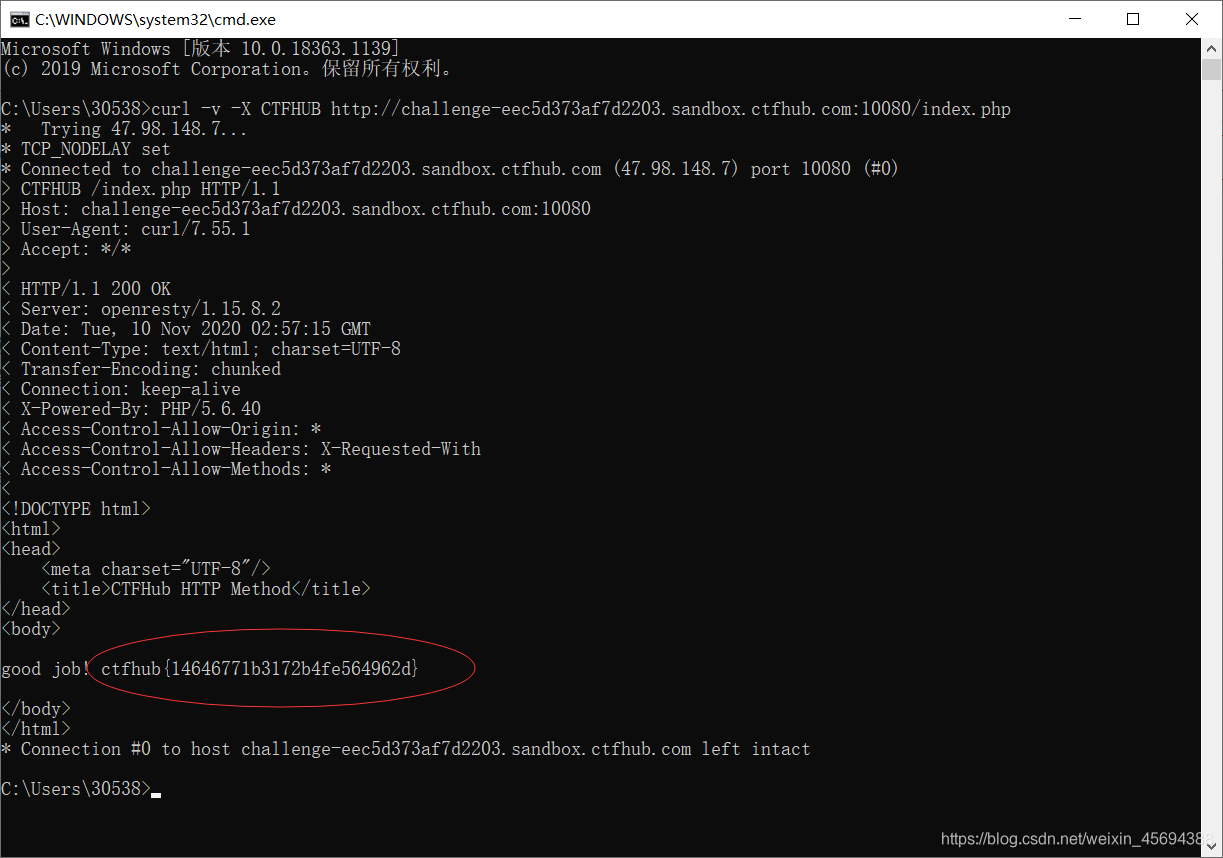打開網頁:

思路一:
根據題目,應該是向網頁發送get方式請求,但并沒有具體規定要發送什么,嘗試get發送參數后,都沒有返回網頁,emmm’…好像不是我想的那種套路
思路二:
網上找到思路有,可以用cmd自帶的命令curl查看http的返回信息
curl -v -X CTFHUB http://challenge-eec5d373af7d2203.sandbox.ctfhub.com:10080/index.php

相當于返回服務器返回的所有信息,包括html源碼,其中包括了flag
curl -v(獲取整個通信過程)
curl -X url(使用特定方法請求網頁文本)
因為HTTP Method 是可以自定義的,并且區分大小寫,直接用 CTFHUB 方法請求 index.php 即可拿到 flag。)
curl使用方法:http://www.ruanyifeng.com/blog/2019/09/curl-reference.html
curl使用方法:
-A
-A參數指定客戶端的用戶代理標頭,即User-Agent。curl 的默認用戶代理字符串是curl/[version]。
$ curl -A 'Mozilla/5.0 (Windows NT 10.0; Win64; x64) AppleWebKit/537.36 (KHTML, like Gecko) Chrome/76.0.3809.100 Safari/537.36' https://google.com
上面命令將User-Agent改成 Chrome 瀏覽器。
$ curl -A '' https://google.com
上面命令會移除User-Agent標頭。
也可以通過-H參數直接指定標頭,更改User-Agent。
$ curl -H 'User-Agent: php/1.0' https://google.com
-b
-b參數用來向服務器發送 Cookie。
$ curl -b 'foo=bar' https://google.com
上面命令會生成一個標頭Cookie: foo=bar,向服務器發送一個名為foo、值為bar的 Cookie。
$ curl -b 'foo1=bar;foo2=bar2' https://google.com
上面命令發送兩個 Cookie。
$ curl -b cookies.txt https://www.google.com
上面命令讀取本地文件cookies.txt,里面是服務器設置的 Cookie(參見-c參數),將其發送到服務器。
-c
-c參數將服務器設置的 Cookie 寫入一個文件。
$ curl -c cookies.txt https://www.google.com
上面命令將服務器的 HTTP 回應所設置 Cookie 寫入文本文件cookies.txt。
-d
-d參數用于發送 POST 請求的數據體。
$ curl -d'login=emma&password=123'-X POST https://google.com/login
# 或者
$ curl -d 'login=emma' -d 'password=123' -X POST https://google.com/login
使用-d參數以后,HTTP 請求會自動加上標頭Content-Type : application/x-www-form-urlencoded。并且會自動將請求轉為 POST 方法,因此可以省略-X POST。
-d參數可以讀取本地文本文件的數據,向服務器發送。
$ curl -d '@data.txt' https://google.com/login
上面命令讀取data.txt文件的內容,作為數據體向服務器發送。
–data-urlencode
–data-urlencode參數等同于-d,發送 POST 請求的數據體,區別在于會自動將發送的數據進行 URL 編碼。
$ curl --data-urlencode 'comment=hello world' https://google.com/login
上面代碼中,發送的數據hello world之間有一個空格,需要進行 URL 編碼。
-e
-e參數用來設置 HTTP 的標頭Referer,表示請求的來源。
curl -e 'https://google.com?q=example' https://www.example.com
上面命令將Referer標頭設為https://google.com?q=example。
-H參數可以通過直接添加標頭Referer,達到同樣效果。
curl -H 'Referer: https://google.com?q=example' https://www.example.com
-F
-F參數用來向服務器上傳二進制文件。
$ curl -F 'file=@photo.png' https://google.com/profile
上面命令會給 HTTP 請求加上標頭Content-Type: multipart/form-data,然后將文件photo.png作為file字段上傳。
-F參數可以指定 MIME 類型。
$ curl -F 'file=@photo.png;type=image/png' https://google.com/profile
上面命令指定 MIME 類型為image/png,否則 curl 會把 MIME 類型設為application/octet-stream。
-F參數也可以指定文件名。
$ curl -F 'file=@photo.png;filename=me.png' https://google.com/profile
上面命令中,原始文件名為photo.png,但是服務器接收到的文件名為me.png。
-G
-G參數用來構造 URL 的查詢字符串。
$ curl -G -d 'q=kitties' -d 'count=20' https://google.com/search
上面命令會發出一個 GET 請求,實際請求的 URL 為https://google.com/search?q=kitties&count=20。如果省略–G,會發出一個 POST 請求。
如果數據需要 URL 編碼,可以結合–data–urlencode參數。
$ curl -G --data-urlencode 'comment=hello world' https://www.example.com
-H
-H參數添加 HTTP 請求的標頭。
$ curl -H 'Accept-Language: en-US' https://google.com
上面命令添加 HTTP 標頭Accept-Language: en-US。
$ curl -H 'Accept-Language: en-US' -H 'Secret-Message: xyzzy' https://google.com
上面命令添加兩個 HTTP 標頭。
$ curl -d '{"login": "emma", "pass": "123"}' -H 'Content-Type: application/json' https://google.com/login
上面命令添加 HTTP 請求的標頭是Content-Type: application/json,然后用-d參數發送 JSON 數據。
-i
-i參數打印出服務器回應的 HTTP 標頭。
$ curl -i https://www.example.com
上面命令收到服務器回應后,先輸出服務器回應的標頭,然后空一行,再輸出網頁的源碼。
-I
-I參數向服務器發出 HEAD 請求,然會將服務器返回的 HTTP 標頭打印出來。
$ curl -I https://www.example.com
上面命令輸出服務器對 HEAD 請求的回應。
–head參數等同于-I。
$ curl --head https://www.example.com
-k
-k參數指定跳過 SSL 檢測。
$ curl -k https://www.example.com
上面命令不會檢查服務器的 SSL 證書是否正確。
-L
-L參數會讓 HTTP 請求跟隨服務器的重定向。curl 默認不跟隨重定向。
$ curl -L -d 'tweet=hi' https://api.twitter.com/tweet
–limit-rate
–limit-rate用來限制 HTTP 請求和回應的帶寬,模擬慢網速的環境。
$ curl --limit-rate 200k https://google.com
上面命令將帶寬限制在每秒 200K 字節。
-o
-o參數將服務器的回應保存成文件,等同于wget命令。
$ curl -o example.html https://www.example.com
上面命令將www.example.com保存成example.html。
-O
-O參數將服務器回應保存成文件,并將 URL 的最后部分當作文件名。
$ curl -O https://www.example.com/foo/bar.html
上面命令將服務器回應保存成文件,文件名為bar.html。
-s
-s參數將不輸出錯誤和進度信息。
$ curl -s https://www.example.com
上面命令一旦發生錯誤,不會顯示錯誤信息。不發生錯誤的話,會正常顯示運行結果。
如果想讓 curl 不產生任何輸出,可以使用下面的命令。
$ curl -s -o /dev/null https://google.com
-S
-S參數指定只輸出錯誤信息,通常與-s一起使用。
$ curl -s -o /dev/null https://google.com
上面命令沒有任何輸出,除非發生錯誤。
-u
-u參數用來設置服務器認證的用戶名和密碼。
$ curl -u 'bob:12345' https://google.com/login
上面命令設置用戶名為bob,密碼為12345,然后將其轉為 HTTP 標頭Authorization: Basic Ym9iOjEyMzQ1。
curl 能夠識別 URL 里面的用戶名和密碼。
$ curl https://bob:12345@google.com/login
上面命令能夠識別 URL 里面的用戶名和密碼,將其轉為上個例子里面的 HTTP 標頭。
$ curl -u 'bob' https://google.com/login
上面命令只設置了用戶名,執行后,curl 會提示用戶輸入密碼。
-v
-v參數輸出通信的整個過程,用于調試。
$ curl -v https://www.example.com
–trace參數也可以用于調試,還會輸出原始的二進制數據。
$ curl --trace - https://www.example.com
-x
-x參數指定 HTTP 請求的代理。
$ curl -x socks5://james:cats@myproxy.com:8080 https://www.example.com
上面命令指定 HTTP 請求通過myproxy.com:8080的 socks5 代理發出。
如果沒有指定代理協議,默認為 HTTP。
$ curl -x james:cats@myproxy.com:8080 https://www.example.com
上面命令中,請求的代理使用 HTTP 協議。
-X
-X參數指定 HTTP 請求的方法。
$ curl -X POST https://www.example.com
上面命令對https://www.example.com發出 POST 請求。
強行總結:
這位老哥整理的挺好(三聯支持),還有亂碼的解決方式,我先嫖一下下,下次一定。。。
https://blog.csdn.net/qq_45738111/article/details/105265455











 -------WP)




 布爾盲注)

文件輸出,時間布爾盲注)
 安裝PyTorch 1.8 的可行方案)